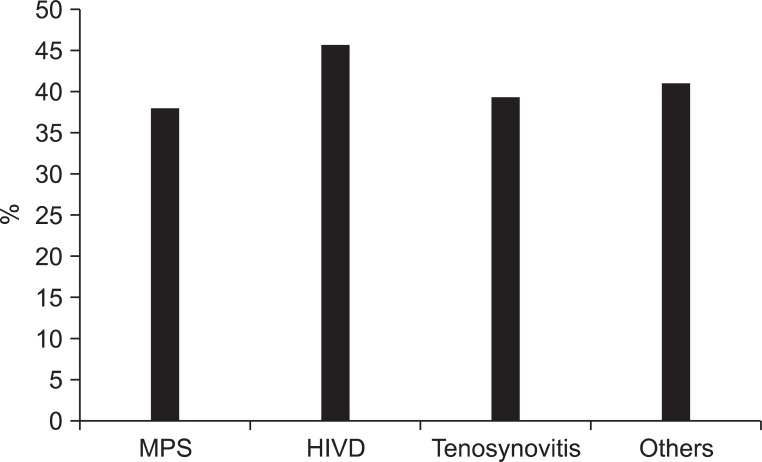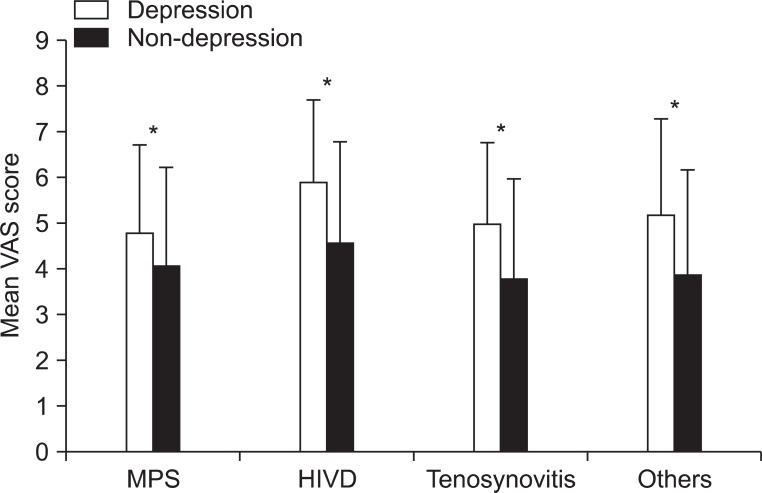Ann Rehabil Med.
2012 Dec;36(6):836-840.
The Prevalence and Characteristics of Depression in Work-related Musculoskeletal Disease
- Affiliations
-
- 1Department of Physical Medicine and Rehabilitation, Hanyang University Guri Hospital, Guri 471-701, Korea. stephan72@naver.com
Abstract
OBJECTIVE
To reveal the relationship between depression and WMSD. METHOD: Five physiatrists participated in the workplace musculoskeletal survey and diagnosed 724 office workers with WMSD by performing detailed history taking and physical examination. All subjects were asked to answer the Korean version of the Beck depressive inventory (K-BDI), and to express their pain according to the visual analogue scale (VAS) score. We categorized the subjects into 4 groups, myofascial pain syndrome (MPS), herniated intervertebral disk (HIVD), tenosynovitis, and others, and investigated the prevalence of depression in desk workers and relationship between WMSD and depression, and we compared pain intensity between the depression and non-depression groups. Correlation analysis was carried out between K-BDI and VAS scores in each group.
RESULTS
The mean K-BDI score were 8.7+/-6.68. The prevalence of depression was higher in females than in male, and there was no relationship between age and depression. There was a significant connection between HIVD and depression (p<0.05). However, the other groups did not have significant connection to depression. The VAS score (5.02) of the depression group was significantly higher than that (4.10) of the non-depression group. In addition, there was a significant difference of VAS scores between the depression group and non-depression group in each disease group.
CONCLUSION
The mean VAS score of the depression group in WMSD was significantly higher than in the non-depression group. The correlation between BDI and VAS scores in the subjects was present, and the highest was in the HIVD group.
Keyword
MeSH Terms
Figure
Reference
-
1. Lee EC, Kim HC, Jung DY, Kim DH, Leem JH, Park SG. Association between job-stress and VDT Work, and musculoskeletal symptoms of neck and shoulder among white-collar workers. Korean J Occup Environ Med. 2007; 19:187–195.
Article2. Yoo WG, Yi CH, Kim MH. Effects of a proximity-sensing feedback chair on head, shoulder, and trunk postures when working at a visual display terminal. J Occup Rehabil. 2007; 16:631–637. PMID: 17086500.
Article3. Kang YK. Evaluation and management of chronic pain. J Korean Acad Fam Med. 2003; 24:103–111.4. Shin YK, Lee CU. Depressive disorder in patients with chronic pains. J Korean Pain Soc. 2002; 15:110–115.5. Patten SB, Williams JV, Wang J. Mental disorders in a population sample with musculoskeletal disorders. BMC Musculoskelet Disord. 2006; 7:37. PMID: 16638139.
Article6. Harter M, Reuter K, Weisser B, Schretzmann B, Aschenbrenner A, Bengel J. A descriptive study of psychiatric disorders and psychosocial burden in rehabilitation patients with musculoskeletal diseases. Arch Phys Med Rehabil. 2002; 83:461–468. PMID: 11932846.7. Arnold LM, Witzeman KA, Swank ML, McElroy SL, Keck PE. Health-related quality of life using the SF-36 in patients with bipolar disorder compared with patients with chronic back pain and the general population. J Affect Disord. 2000; 57:235–239. PMID: 10708837.
Article8. Rundall TG, Shortell SM, Wang MC, Casalino L, Bodenheimer T, Gillies RR, Schmittdiel JA, Oswald N, Robinson JC. As good as it gets? Chronic care management in nine leading US physician organisations. BMJ. 2002; 325:958–996. PMID: 12399351.
Article9. Grevitt M, Pande K, O'Dowd J, Webb J. Do first impressions count? A comparison of subjective and psychologic assessment of spinal patients. Eur Spine J. 1998; 7:218–222. PMID: 9684955.10. Shin HC, Kim CH, Park YW, Cho BL, Song SW, Yun YH, Ou SW. Validity of beck depression inventory (BDI): detection of depression in primary care. J Korean Acad Fam Med. 2000; 21:1451–1465.11. Beck AT, Ward CH, Mendelson M, Mock J, Erbaugh J. An inventory for measuring depression. Arch Gen Psychiatry. 1961; 4:561–571. PMID: 13688369.
Article12. Kim SJ, Kim WS, Kang YK, Lee SH, Cho SH. Influencing psychologic factors and stress in patients with chronic pain. J Korean Acad Rehabil Med. 2000; 24:1161–1167.13. Kim DH, Kim TH, Kim JL, Lee H, Kim SA, Oh KY. Screening test for depression using the SF-36 health survey in patients with chronic musculoskeletal pain. J Korean Acad Rehabil Med. 2007; 31:434–439.14. Seok H, Son BK, Ha YR, Ryu HH, Moon JH. Clinical influence of emotional depression on chronic low back pain. J Korean Acad Rehabil Med. 2003; 27:568–574.15. Sohn MK, Chae JM, Yune SH. Pain and psychometric characteristics related to disability evaluation in patients with chronic low back pain. J Korean Acad Rehabil Med. 2000; 24:125–131.16. Steer RA, Beck AT. Sartorius N, Ban TA, editors. Applications of the beck depression inventory. Assessment of depression. 1986. Berlin: Springer Verlag;p. 123–142.
Article17. Klinkman MS, Coyne JC, Gallo S, Schwenk TL. False positives, false negatives, and the validity of the diagnosis of major depression in primary care. Arch Fam Med. 1998; 7:451–461. PMID: 9755738.
Article18. Currie SR, Wang J. Chronic back pain and major depression in the general Canadian population. Pain. 2004; 107:54–60. PMID: 14715389.
Article19. Currie SR, Wang J. More data on major depression as an antecedent risk factor for fist onset of chronic back pain. Psychol Med. 2005; 35:1275–1282. PMID: 16168150.20. Ohayon MM, Schatzberg AF. Using chronic pain to predict depressive morbidity in the general population. Arch Gen Psychiatry. 2003; 60:39–47. PMID: 12511171.
Article
- Full Text Links
- Actions
-
Cited
- CITED
-
- Close
- Share
- Similar articles
-
- Association between Job-related Factors and Musculoskeletal Symptoms in University Hospital Healthcare Workers
- Characteristics of Work-Related Musculoskeletal Disorders and Effect of Intervention Program in Shipyard Workers
- The Impact on the Musculoskeletal Symptoms of the Warehouse Employees's Work-related Characteristics and Job Stress
- The Relationship between Firefighters' Work Demand and Work-related Musculoskeletal Disorders: The Moderating Role of Task Characteristics
- Relationship between Comorbid Health Problems and Musculoskeletal Disorders Resulting in Musculoskeletal Complaints and Musculoskeletal Sickness Absence among Employees in Korea



